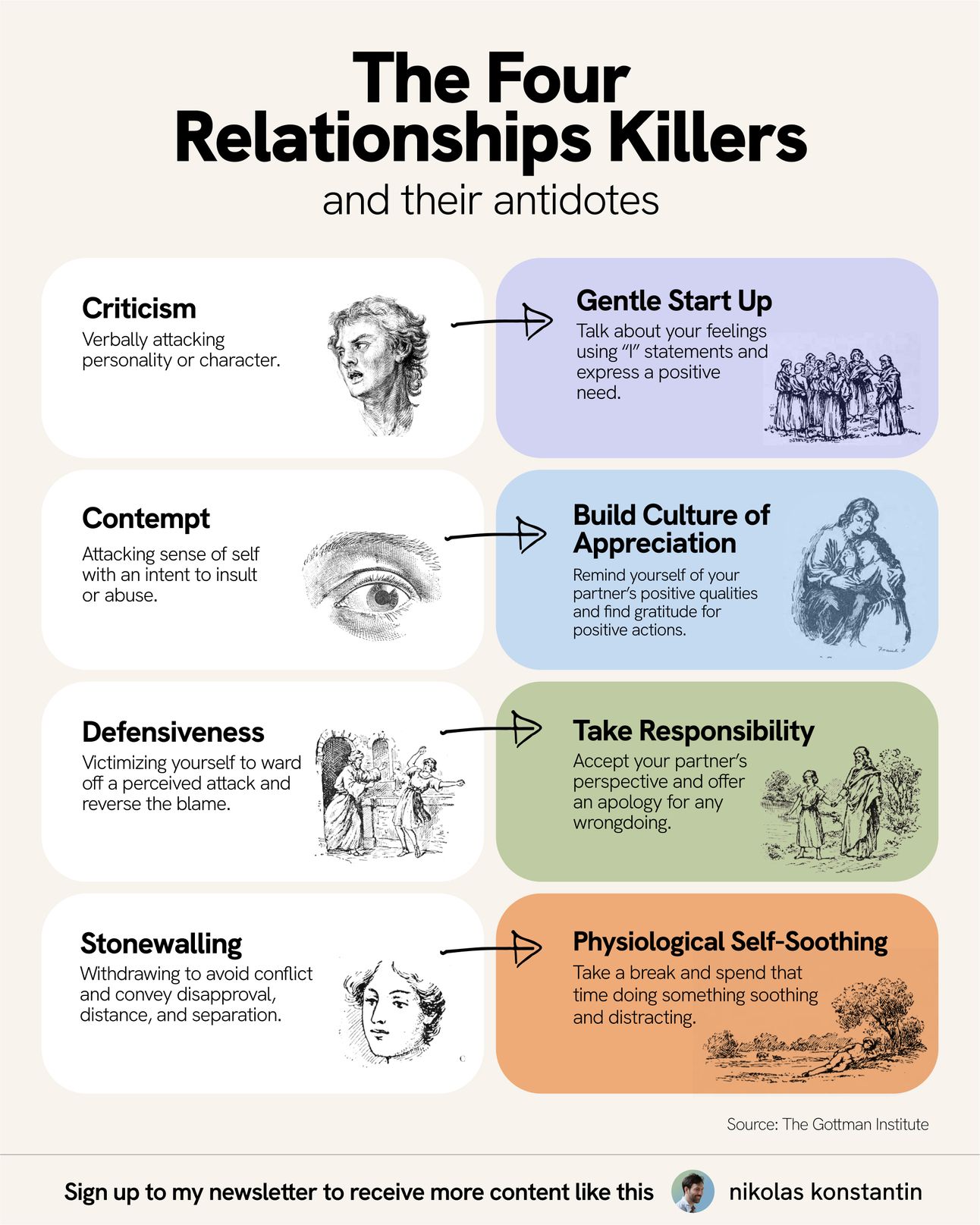- The Mindful CEO
- Posts
- How to spot the 4 relationship killers
How to spot the 4 relationship killers
4 ways to avoid slowly killing what matters most

Here is the most effective way to kill your organization:
Eroding Relationships!
I have been called to fix many uncomfortable situations:
Co-founders that stop speaking with each other.
Leadership team members screaming insults at the CEO.
Investors suing their asses, because of broken pride.
You don't want to go down that route.
You don’t want to call someone in to help mend what didn't have to break.
And you dont have to.
Here are science-backed ways to fuck up a good relationship. And proven ways to avoid fucking it up in the first place:
Enter the 4 Relationship Killers (aka Horsemen)
The four relationship killers - aka 4 Horsemen are Criticism, Contempt, Defensiveness, and Stonewalling (created by relationship expert John Gottman).
When applied to leadership, the Four Killers—criticism, contempt, Defensiveness, and Stonewalling—reflect toxic communication patterns that can undermine a leader’s effectiveness, erode team morale, and lead to organizational dysfunction.

Here’s how each horseman might appear in a leadership context and what leaders can do to counteract these patterns:
1. Criticism
Criticism in a leadership context involves blaming, personal attacks, or finding fault in others without offering constructive feedback. You point out what’s wrong with the “person” rather than focusing on a specific behavior or outcome.
Example: You use a fixed mindset phrasing:“You always mess up presentations. You’re just not detail-oriented enough,” instead of addressing the issue objectively: “The last presentation had some errors—let’s look at how we can improve this moving forward.”
Impact: Unconstructive Criticism from a leader can lead to a culture of fear and blame. It discourages risk-taking, damages trust, and can create a defensive atmosphere more focused on avoiding mistakes than achieving results.
Antidote: Use Gentle Start-Ups: Frame feedback around behaviors and specific situations, focusing on the issue rather than the person.
2. Contempt
Contempt manifests when leaders express superiority or disrespect toward team members. It can include sarcasm, ridicule, or belittling remarks that make subordinates feel undervalued and disrespected.
Example: You say, “Wow, I can’t believe you don’t know this. It’s so basic,” while rolling your eyes in a meeting. This makes the other feel small and hesitant to contribute further.
Impact: Contempt signals a lack of respect and can result in widespread resentment, lower team morale, and disengagement. Over time, it leads to high employee turnover and a toxic work environment.
Antidote: Build a Culture of Respect and Appreciation: Regularly express appreciation and respect for colleagues and ensure that positive interactions outweigh negative ones.
3. Defensiveness
A defensive leader refuses to accept responsibility for mistakes, deflects blame, and often responds to feedback with excuses or counter-attacks.
Example: When confronted about a decision that negatively impacted the team, you say, “Well, it’s not my fault—none of you gave me any good ideas. I had no choice but to do it this way.”
Impact: Defensiveness prevents growth and creates a blame-oriented culture. It discourages open communication and can lead to a lack of psychological safety. Giving feedback or pointing out potential issues becomes pointless or dangerous.
Antidote: Take Responsibility: Role model a culture where admitting mistakes is safe and seen as a sign of strength rather than weakness.
4. Stonewalling
Stonewalling occurs when leaders emotionally withdraw, shut down, or avoid engagement when faced with difficult conversations or challenges. This can look like a leader ignoring emails, staying silent in meetings, or refusing to address conflicts directly.
Example: You might stop attending meetings or dismiss team concerns by saying, “We’ll talk about it later,” without ever addressing the issue. This creates frustration and leaves problems unresolved.
Impact: Stonewalling from leaders can paralyze teams and create an environment of uncertainty. It leaves employees feeling unsupported and undervalued.
Antidote: Practice Self-Soothing and Engagement: If overwhelmed, take a break to reset, then re-engage in the discussion, focusing on constructive outcomes.
Why the 4 Relationship Killers Matter in Leadership
When leaders exhibit these toxic communication patterns (or horsemen), they ripple throughout the organization.
Employees tend to mirror their leaders' behavior, so if a leader is critical, defensive, contemptuous, or disengaged, it sets the tone for the entire organization.
To address these behaviors, you can apply these 4“antidotes”:
1. Criticism → Use Gentle Start-Ups: Frame feedback around behaviors and specific situations, focusing on the issue rather than the person.
2. Contempt → Build a Culture of Respect and Appreciation: Regularly express appreciation and respect for colleagues, and ensure that positive interactions outweigh negative ones.
3. Defensiveness → Take Responsibility: Encourage a culture where admitting mistakes is safe and seen as a sign of strength rather than weakness.
4. Stonewalling → Practice Self-Soothing and Engagement: If overwhelmed, take a break to reset, then re-engage in the discussion focusing on constructive outcomes.

““Successful long-term relationships are created through small words, small gestures, and small acts."

Let’s be real.
Relationships are hard.
Even with best-in-class frameworks like these.
Write me about what comes up reflecting on this model and where you would need more support.
Yours,

P.S. Leading is hard. Here is how I can support you to lead yourself and your organization:
A la Carte Executive Training:
Each year, I support a few leaders & their organizations in transforming into more resonant versions of themselves. Want to be coached by me? Want to apply the models you are reading here in your leadership? Say hello.
The Yearly Reflection Space for Leaders:
A Beautiful Mind for Executives
If you want to train your mind with deep training from science and meditation traditions, this one is for you. My virtual “A Beautiful Mind Course” for Executives. Train here.
A CEO Playbook library with the best of Management and Leadership:
I scan the best of leadership literature and mindfulness so my clients can focus on what matters most—building a thriving organization. My client's CEO Playbooks library features the best management and leadership theory. You can have exclusive access here.

Three Pillars of Wise Leadership
PPS: And because you deserve it - here is your bonus.
My 10 “Most Popular Mini Leadership Guides”:

Thanks for reading.
Did you enjoy this mail?
Is there a topic you want to read?
Would you like to see anything changed?
Just reply to this mail. I will get back to you.
Enjoy the newsletter?
Please forward this to a pal. It only takes 18 seconds. Writing this one took 6 hours.
See you next Monday,

